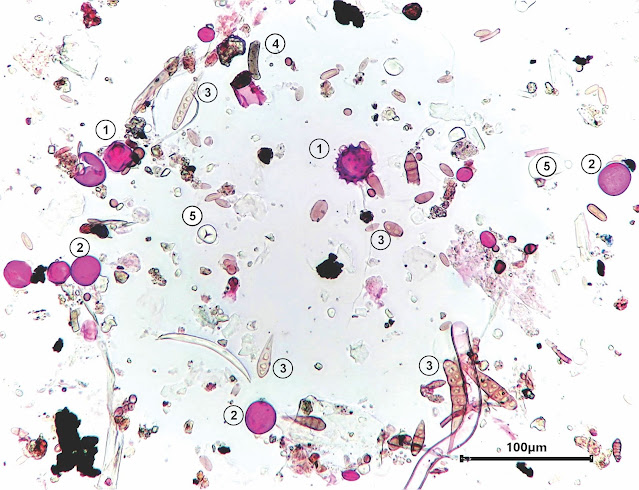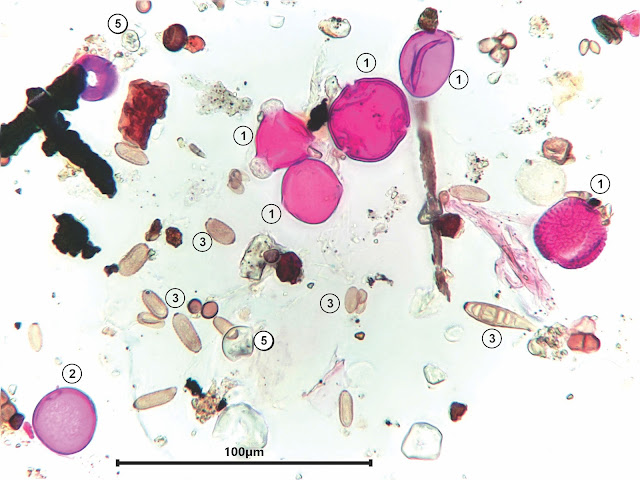A day of sneezing and irritated eyes again, now that it has rained in Milton. Here is what I found in the air and put under the microscope - masses of pollen grains, fungal spores and even starch grains! The sample is from a comparable day last week, when I rinsed a roughly 30cm x 30cm (1 square foot) piece of fine netting that had been on the washing line for 18 hours!
The various types are shown with numbered examples on the following figures, using the labelling:
- Pollen grains from flowering plants stained red and can vary a lot in shape and size
- Pollen grains from grass - are stained red, plain ovals with a single pore, and can vary in size
- Fungal spores - generally brown, beige or grey, ranging from lage paddle shapes to small ovals
- Fragments of fungal hyphae - look like broken brown twigs
- Starch grains - variable sizes, transparent, circular to oval with a hint of a central marking
From the first picture above you can get an idea of the abundance of pollen and fungal spores in 1/600 of the collected material. The spiky pink pollen comes from a plant in the daisy family.
For us hayfever sufferers, our problem is compounded by the fact that all these very small particles stick quite readily to our hair, faces and clothes. Our symptoms can be triggered if even if just a few become loose when we move indoors or go to bed, hence the advice to wash hair and change outer clothes frequently if you do suffer badly from hayfever. Thank heavens that many of our cars have pollen filters!
I calculated that overall my total sample from a small piece of netting contains about
- 7,200 pollen grains
- 42,000 fungal spores
- 600 starch grains
Hayfever is when our own immune system becomes sensitive to airborne dust, pollen, spores, hair, for example, treating them as a threat and trying to protect us. Unfortunately, our eyes and noses are the areas most likely to be exposed and react. What's more, each one of us develops our own typical allerge to one or more of the many different particles in the air.
I can manage with taking hayfever tablets daily during the main hayfever season, and eyedrops when it is particularly bad on the eyes. I only need to avoid going out on particularly bad days. Many others suffer much more seriously and find their lives dramatically impaired. In those cases it is worth seeing if your doctor or health system offer both a service to identify your specific allergens and a possible corresponding desensitisation program. two useful lins in the UK are:
- NHS Hayfever page https://www.nhs.uk/conditions/hay-fever/
- AllergyUK https://www.allergyuk.org/types-of-allergies/hayfever/
- A page from the US NIH on desensitisation https://www.ncbi.nlm.nih.gov/books/NBK279487/
There is also another side to being able to capture and identify pollens and spores - in forensics, when trying to match a person or vehicle to a crime location. Here, the fact that pollen and spores are so pernicious and will be very specific to locations helps, as illustrated in a fantastc book by Patricial Wiltshire 'Traces' - https://www.amazon.co.uk/Traces-forensic-scientist-criminal-investigator/dp/1788700635/ref=tmm_pap_swatch_0?_encoding=UTF8&qid=1688324266&sr=8-1
Airborne particles. I hadn't really realised how abundant they are! My sympathy if you are a hayfever sufferer.
For your interest, below are some more images from the airborne pollen sample.
The caplet shaped pollens are from the same family as Cow Parsley.




No comments:
Post a Comment
Note: only a member of this blog may post a comment.